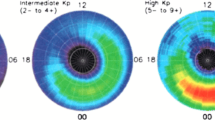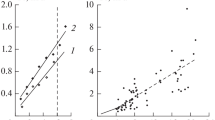Abstract
This paper analyzes the role of the outer ionosphere in the occurrence of a large difference in the frequency of accelerated electron fluxes in the auroral region in the premidnight sector for winter and summer conditions, which are associated with discrete auroras. Simulation indicates that the critical value JEIC of the longitudinal current of the Alfvén wave for the development of electrostatic ion–cyclotron instability at heights around the Earth’s radius (h ~ RE) for winter almost coincides with the upper limit of average values of the stationary large-scale longitudinal current. Therefore, weak fluctuations of the longitudinal current associated with the Alfvén wave are sufficient in winter for the development of processes leading to accelerated electron fluxes, which are associated with discrete auroras. The summer value of JEIC is four to five times higher than that for winter, and a stimulated precipitation of auroral electrons is likely to be possible only at high geomagnetic activity. The winter/summer asymmetry in the JEIC value is mainly associated with specific changes in the parameters of the outer ionosphere along the geomagnetic field. The difference in electron density reaches a maximum at heights h ~ RE, where the summer values of this density are five to six times higher than the winter ones, which, in turn, is associated with higher summer temperatures of electrons and ions. The important role of these temperatures in the winter/summer asymmetry in the frequency of accelerated electrons has been noted, it would seem, for the first time.

Similar content being viewed by others
REFERENCES
Carpenter, D.L. and Anderson, R.R., An ISEE/whistler model of electron density in the magnetosphere, J. Geophys. Res., 1992, vol. 97, no. A2, pp. 1097–1108.
Cattell, C., Dombeck, J., and Hanson, L., Solar cycle effects on parallel electric field acceleration of auroral electron beams, J. Geophys. Res., 2013, vol. 118, pp. 5673–5680. https://doi.org/10.1002/jgra.50546
Deminov, M.G., The Earth’s ionosphere, in Plazmennaya geliogeofizika, Zelenyi, L.M. and Veselovskii, I.S., Eds., Moscow: Fizmatlit, 2008, vol. 2, pp. 92–163.
Deminov, M.G. and Deminova, G.F., Winter anomaly of the E-layer critical frequency in the nighttime auroral zone, Geomagn. Aeron. (Engl. Transl.), 2017, vol. 57, no. 5, pp. 584–590.
Deminov, M.G. and Deminova, G.F., Winter anomaly in the critical frequency of the nighttime polar ionosphere’s E layer, Cosmic Res., 2019, vol. 57, no. 1, pp. 29–35.
Deminov, M.G., Oraevskii, V.N., and Ruzhin, Yu.,Ya. Ionospheric–magnetospheric effects of rockets launched toward high latitudes, Geomagn. Aeron. (Engl. Transl.), 2001, vol. 41, no. 6, pp. 738–746.
Gaidukov, V.Yu., Deminov, M.G., Dumin, Yu.V., et al., The Auroral Trigger experiment. 1. Generation of electric fields and particle fluxes by the injection of plasma-forming compounds into the high-latitude ionosphere, Kosm. Issled., 1993, vol. 31, no. 1, pp. 54–62.
Holt, J.M., Zhang, S.-R., and Buonsanto, M.J., Regional and local ionospheric models based on Millstone Hill incoherent scatter radar data, Geophys. Res. Lett., 2002, vol. 29. https://doi.org/10.1029/2002GL014678
Iijima, T. and Potemra, T.A., The amplitude distribution of field-aligned currents at northern high latitudes observed by Triad, J. Geophys. Res., 1976, vol. 81, no. 13, pp. 2165–2174.
Johnson, M.T. and Wygant, J.R., The correlation of plasma density distributions over 5000 km with solar illumination of the ionosphere: Solar cycle and zenith angle observations, Geophys. Res. Lett., 2003, vol. 30, no. 24, p. 2260. https://doi.org/10.1029/2003GL018175
Kindel, J.M. and Kennel, C.F., Topside current instabilities, J. Geophys. Res., 1971, vol. 76, no. 13, pp. 3055–3078.
Kletzing, C.A., Mozer, E.S., and Torbert, R.B., Electron temperature and density at high latitude, J. Geophys. Res., 1998, vol. 103, no. A7, pp. 14837–14845.
Korth, H., Zhang, Y., Anderson, B.J., et al., Statistical relationship between large-scale upward field-aligned currents and electron precipitation, J. Geophys. Res., 2014, vol. 119, pp. 6715–6731.
Liperovskii, V.A. and Pudovkin, V.I., Anomal’noe soprotivlenie i dvoinye sloi v magnitosfernoi plazme (Abnormal Resistance and Double Layers in Magnetospheric Plasma), Moscow: Nauka, 1983.
Morooka, M. and Mukai, T., Density as a controlling factor for seasonal and altitudinal variations of the auroral particle acceleration region, J. Geophys. Res., 2003, vol. 108, no. 7, p. 1306. https://doi.org/10.1029/2002JA009786
Newell, P.T., Meng, C.-I., and Lyons, K.M., Suppression of discrete aurorae by sunlight, Nature, 1996, vol. 381, no. 6585, pp. 766–767.
Newell, P.T., Greenwald, R.A., and Ruohoniemi, J.M., The role of the ionosphere in aurora and space weather, Rev. Geophys., 2001, vol. 39, no. 2, pp. 137–149.
Newell, P.T., Sotirelis, T., and Wing, S., Seasonal variations in diffuse, monoenergetic, and broadband aurora, J. Geophys. Res., 2010, vol. 115, A03216. https://doi.org/10.1029/2009JA014805
Pokhotelov, D., Lotko, W., and Streltsov, A.V., Effects of the seasonal asymmetry in ionospheric Pedersen conductance on the appearance of discrete aurora, Geophys. Res. Lett., 2002, vol. 29, no. 10, p. 1437. https://doi.org/10.1029/2001GL014010
Titheridge, J.E., Temperatures in the upper ionosphere and plasmasphere, J. Geophys. Res., 1998, vol. 103, no. A2, pp. 2261–2277.
Trakhtengerts, V.Yu. and Feldstein, A.Ya., Turbulent Alfvén boundary layer in the polar ionosphere. 1. Excitation conditions and energetics, J. Geophys. Res., 1991, vol. 96, no. A11, pp. 19363–19374.
Zhang, S.-R., Holt, J.M., van Eyken, A.P., et al., Ionospheric local model and climatology from long-term databases of multiple incoherent scatter radars, Geophys. Res. Lett., 2005, vol. 32, L20102. https://doi.org/10.1029/2005GL023603
Zhang, S.-R., Holt, J.M., Bilitza, D.K., et al., Multiple-site comparisons between models of incoherent scatter radar and IRI, Adv. Space Res., 2007, vol. 39, pp. 910–917.
Funding
This work was supported by the Russian Foundation for Basic Research, project no. 20-05-00050.
Author information
Authors and Affiliations
Corresponding author
Additional information
Translated by V. Arutyunyan
Rights and permissions
About this article
Cite this article
Deminov, M.G. Role of the Outer Ionosphere in the Winter/Summer Asymmetry of Auroral Electron Precipitations. Geomagn. Aeron. 60, 472–476 (2020). https://doi.org/10.1134/S0016793220040052
Received:
Revised:
Accepted:
Published:
Issue Date:
DOI: https://doi.org/10.1134/S0016793220040052




